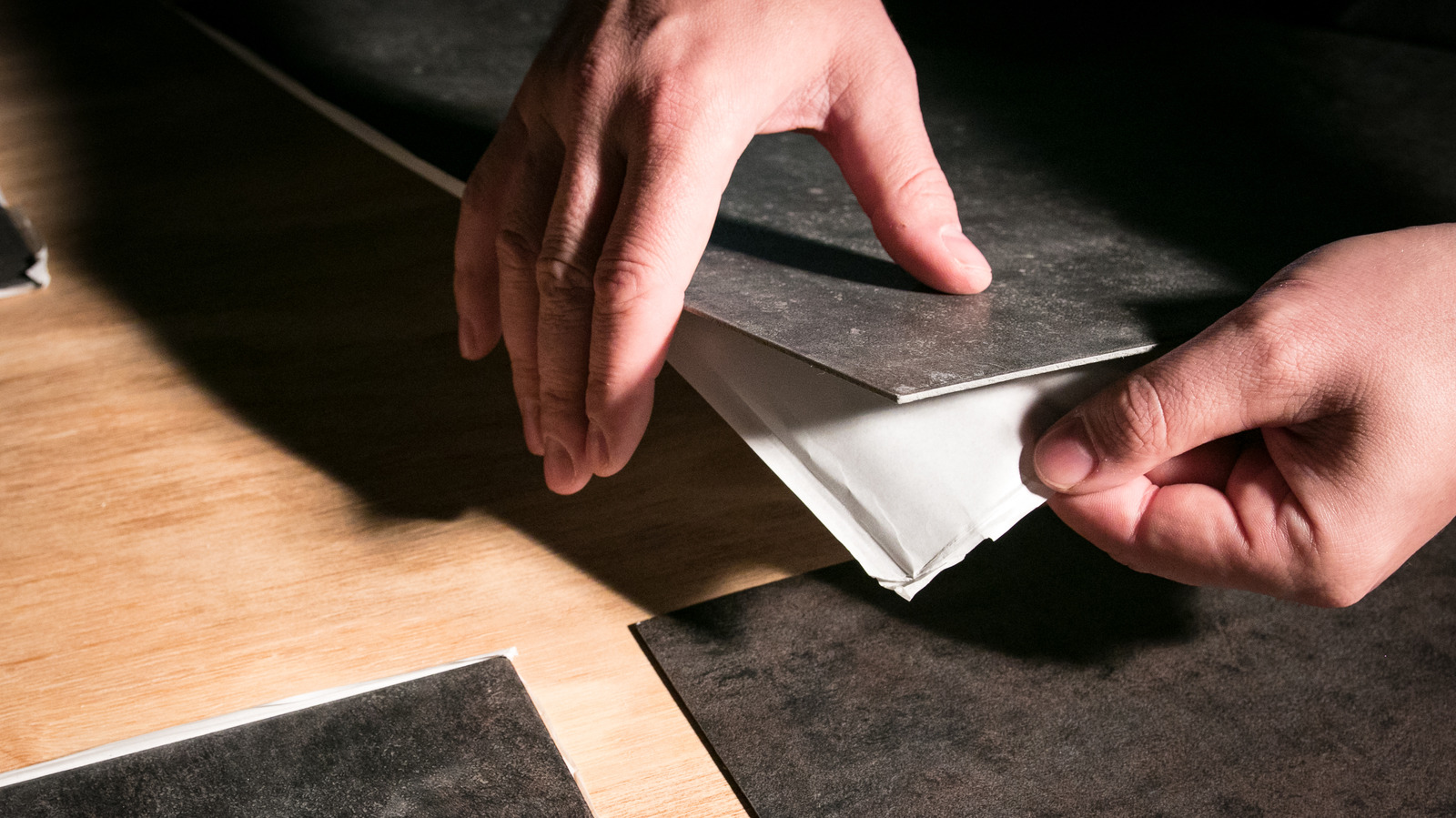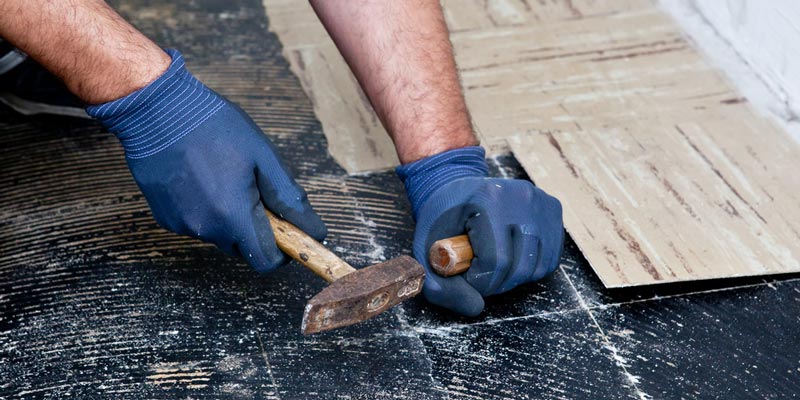Have you ever moved into a new house or apartment and found yourself staring down at a floor covered in sticky, outdated tiles? Or perhaps you’re simply ready for a change and want to replace your old tiles, but the adhesive stubbornly refuses to budge? These sticky remnants can feel like an insurmountable obstacle, but they don’t have to be. Fear not, because this guide will arm you with the knowledge and techniques to conquer those pesky tiles and reclaim the pristine beauty of your floors.

Image: viewfloor.co
Removing sticky floor tiles can be a daunting task, but with the right tools and a strategic approach, it’s achievable. Whether you’re dealing with self-adhesive tiles or tiles with a strong adhesive backing, this guide will walk you through the process step-by-step, ensuring you can remove those unwanted tiles quickly and efficiently while minimizing damage to your underlying flooring.
Understanding Your Enemy: The Sticky Tile
The first step in overcoming any challenge is understanding your opponent. In this case, the enemy is the adhesive used to attach the tiles to your floor. While there are various types of adhesives used, they all share a common goal: to create a strong bond. This bond, however, is what makes removal challenging.
The strength of the adhesive varies depending on several factors, including:
- Type of Adhesive: There are several types of adhesive used for floor tiles, including pressure-sensitive adhesives, epoxy adhesives, and mastic adhesives. Each type has varying levels of adhesion and requires different removal techniques.
- Age of the adhesive: Older adhesives tend to become more brittle and easier to remove. Newer adhesives, however, can be more stubborn and require more aggressive methods.
- Type of flooring: The type of flooring your tiles are attached to can impact the removal process. Some surfaces, like concrete, are more forgiving than others, such as wood floors, where caution and precision are crucial.
- Environmental factors: Temperature and humidity can affect the adhesive’s stickiness. Hot, humid conditions tend to make adhesives more pliable and easier to remove, while cold, dry conditions can make them harder to work with.
Arming Yourself for Battle: Tools and Materials
With an understanding of your adhesive foe, it’s time to assemble your arsenal of tools and materials. Having the right equipment will make the job much easier and safer. Depending on the type of adhesive and the flooring you’re working with, you might need the following:
- Protective Gear: Safety first! Always wear gloves to protect your hands from the adhesive and dust. Depending on the adhesive, a face mask and eye protection are also recommended.
- Heavy Duty Putty Knife or Scraper: This is your primary weapon against the adhesive. Choose a scraper with a sturdy blade and comfortable handle. The size and shape of the scraper will depend on the size of the tile and the adhesive.
- Utility Knife: Used for scoring the adhesive in sections to break it up and make scraping easier.
- Heat Gun or Hairdryer: Heating the adhesive can make it more pliable and easier to remove. Be cautious when using heat as it can damage some flooring surfaces.
- Chemical Adhesive Remover: For stubborn adhesives that don’t readily come off with other methods, a chemical remover can be a powerful ally. Choose a remover specifically designed for the type of adhesive you’re dealing with, and follow all safety precautions on the product label. Consider wearing a respirator to protect your lungs from potentially harmful fumes.
- Cleaning Supplies: You’ll need a bucket of warm water, soap, and cleaning cloths to clean up adhesive residue once the tiles are removed.
- Vacuum Cleaner: A vacuum cleaner with a dust attachment can efficiently remove any loose debris and dust.
Tactical Approaches: Proven Techniques for Tile Removal
Now that you’re equipped for battle, let’s delve into the tactical maneuvers for removing those stubborn tiles. Each approach has its own strengths and weaknesses, so you can choose the best method for your situation.

Image: phenergandm.com
1. The Heat and Scraping Method
This method is often effective for self-adhesive tiles and some types of mastic adhesive. The heat softens the adhesive, making it easier to scrape off. Here’s how to do it:
- Prepare the area: Clear any furniture or objects near the tiles to prevent accidents. It’s also a good practice to cover nearby furniture with drop cloths to protect them from any accidental spills or debris.
- Apply heat: Use a heat gun or hairdryer to gently heat the tile. Don’t overheat it as prolonged exposure to heat can damage your underlying floor. Be particularly cautious with wood floors as they can be susceptible to heat damage.
- Start scraping: Once the adhesive is softened, carefully insert a putty knife or scraper under the edge of the tile. Gently pry the tile up and slowly work your way around the perimeter.
- Remove the tile: If the adhesive is sufficiently softened, the entire tile should peel off. If you encounter resistance, reapply heat and try again. Never force a tile off as this can damage your flooring.
- Clean up the residue: Once the tile is removed, use a scraper or putty knife to remove any remaining adhesive. If necessary, use a chemical remover for stubborn adhesive. Clean the residue thoroughly with soap and water before proceeding with the next section.
- Protect your flooring: Always protect your flooring, especially if it’s wood, by placing a cloth or cardboard over the area where you are working. This will help prevent scratches, gouges, or other damage caused by the scraper.
2. The Soaking and Scraping Method
This approach utilizes water and time to soften the adhesive. It works well for some mastic adhesives but might take longer than the heat-and-scrape method.
- Saturate the area: Wet the tile and surrounding area thoroughly with warm water. Allow the water to sit for several minutes to soak into the adhesive.
- Start Scraping: Use a putty knife or scraper to scrape off any loosened adhesive. If the adhesive is still stubborn, repeat the soaking and scraping process.
- Remove the tile: Once the adhesive is sufficiently softened, you should be able to carefully peel off the tile. Work slowly and carefully to avoid damage to your flooring.
- Clean up: Remove remaining adhesive residue and thoroughly clean the area with soap and water.
3. The Chemical Remover Method
This method is best used for tough adhesives or when other methods have failed. Always choose a remover specifically designed for the type of adhesive you’re dealing with and observe safety precautions on the product label. Work in a well-ventilated area and wear appropriate safety gear to protect yourself from fumes.
- Apply the remover: Carefully apply the remover to the adhesive, following the instructions on the label. Wait for the specified time to allow the remover to work.
- Scrape and clean: After the recommended waiting time, you can scrape off the softened adhesive with a putty knife or scraper.
- Thorough cleaning: Remove any remaining adhesive residue and clean the area thoroughly with water and soap. For stubborn residues, you might need to repeat the process or use a different type of remover.
Additional Combat Strategies: Tips and Tricks
Beyond the primary approaches, there are a few extra strategies that can be useful as you wage war against those sticky tiles:
- Use a scoring tool: If the adhesive is particularly tough, scoring it with a utility knife can help break it apart and make it easier to remove. Score the adhesive in a grid pattern and then peel up the adhesive in sections.
- Employ a combination of methods: Feel free to combine different approaches for best results. For example, you could use heat to soften the adhesive, then use a scraper to remove it, and finally use a chemical remover to address any remaining residue.
- Work in smaller sections: Instead of tackling the entire area at once, divide the job into smaller sections to make the process less overwhelming.
- Be patient: Removing sticky tiles can be a time-consuming task. Don’t rush the process, and take your time to avoid damaging your flooring.
- Seek professional help: If you’re dealing with a particularly stubborn adhesive or if you’re unsure about tackling the job yourself, it’s always best to reach out to a professional contractor.
The Aftermath: Cleaning and Finishing Touches
You’ve successfully removed the sticky tiles and the battle is won! However, remember to complete the mission by cleaning and preparing the area for your next move.
- Clean the area thoroughly: Remove all adhesive residue, dust, and debris with a damp cloth. If necessary, use a specialized cleaner for the adhesive type.
- Inspect for damage: Once all the residue is gone, carefully inspect the flooring for any damage. If there are scratches or gouges, you may need to repair them before installing new flooring.
- Prepare for new flooring: If you plan to install new flooring, it’s essential to follow the manufacturer’s instructions for proper preparation.
Best Way To Remove Sticky Floor Tiles
A Victory Won: Your Floors Are Clean and Ready for the Future
Removing sticky floor tiles can feel like a formidable task, but with patience, the right tools, and the proper techniques, it’s achievable. By understanding the adhesive, utilizing the appropriate methods, and paying attention to details, you can triumph over those stubborn tiles, leaving your floors clean and ready for the future. And remember, if you encounter any unexpected challenges, don’t hesitate to call in professional help!





